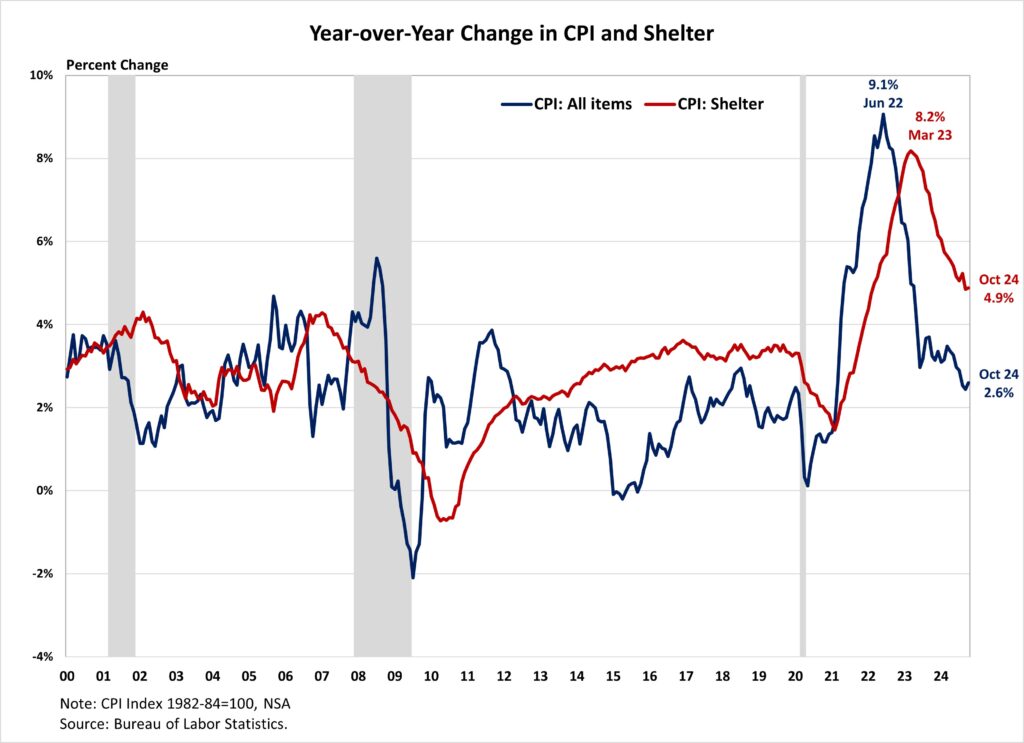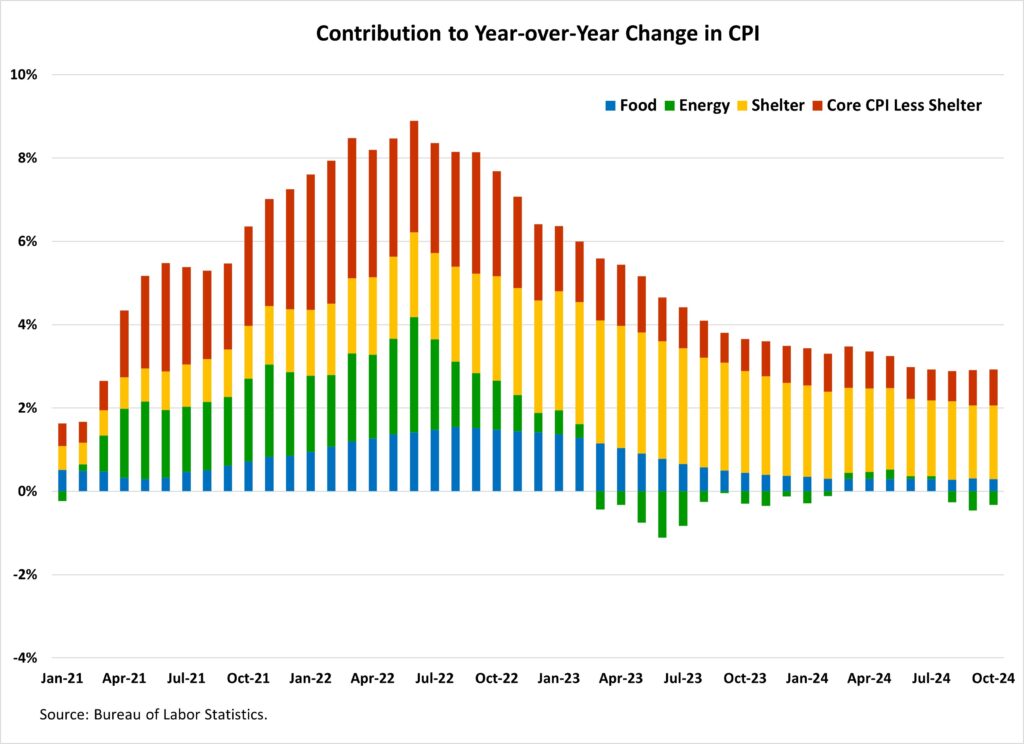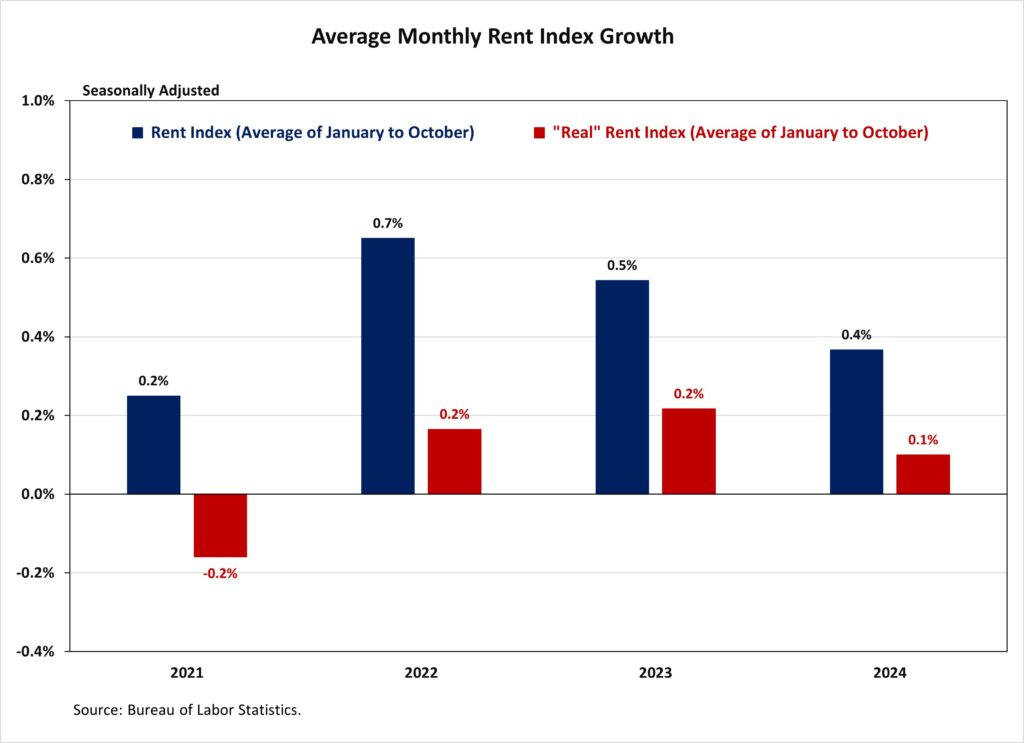
Housing Costs Continue to Fuel Inflation
Inflation increased again in October, indicating that the last push to the 2% objective will be the most difficult.
Shelter expenses continued to be the primary driver of inflation, accounting for more than 65% of the 12-month increase in the all items excluding food and energy index.
However, the year-over-year change in the shelter index has been less than 5% for the second month in a row, indicating a reduction in housing inflation.
While the Fed’s interest rate decreases may alleviate some of the pressure on the housing market, their capacity to address growing housing costs is limited, given these increases are driven by a lack of affordable supply and rising development costs.
In effect, tight monetary policy reduces supply of housing by increasing the cost of AD&C financing.
This is evident in the graph below, as shelter costs continue to climb at a rapid pace despite Fed policy tightening. Increased housing supply is the major solution to reducing housing inflation.
Furthermore, the 2024 election result has brought inflation back into focus and given some downside risks to the economic outlook. Proposed tax cuts and tariffs may raise inflationary pressures, implying a more gradual easing cycle with a slightly higher terminal federal funds rate.
Given the housing market’s sensitivity to interest rates, this might exacerbate the affordability crisis and limit housing supply as builders cope with ongoing supply chain challenges.

According to the Bureau of Labor Statistics, the Consumer Price Index (CPI) increased by 0.2% on a seasonally adjusted basis in October, continuing the trend of the previous three months.
Excluding the volatile food and energy components, the “core” CPI climbed by 0.3% in October, matching the gain in August and September.
The price index for a wide range of energy sources remained steady in October, with decreases in gasoline (-0.9%) and fuel oil (-4.6%) offset by rises in electricity (+1.2%) and natural gas (+0.3%). Meanwhile, the food index grew by 0.2%, following a 0.4% increase in September.
The index for eating away from home increased by 0.2%, while the index for food at home rose by 0.1%.
The shelter index (+0.4%) contributed the most to the monthly increase in the total items index, accounting for more than half of the total increase. Other major factors that increased in October include used vehicle and truck indexes (+2.7%), airline tickets (+3.2%), medical care (+0.3%), and recreation (+0.4%).
Meanwhile, the largest contributors to the reduction were clothes (-1.5%), communication (-0.6%), and household furnishings and operations (-0.1%).
The index for shelter accounts for more than 40% of the “core” CPI. The index rose by 0.4% in October, following a 0.2% increase in September. The indices for owners’ equivalent rent (OER) and rent of primary residence (RPR) rose by 0.4% and 0.3%, respectively, over the month.
These advances have been the most significant contributions to headline inflation in recent months.

On a non-seasonally adjusted basis, the CPI increased by 2.6% in October over the previous year, following a 2.4% rise in September. The “core” CPI grew by 3.3% over the last year, matching the gain seen in September. The food index increased by 2.1%, but the energy index declined by 4.9%.
The NAHB creates a “real” rent index to determine whether rent inflation is faster or slower than overall inflation. It gives information on the availability and demand for rental homes.
When rent inflation exceeds general inflation, the actual rent index increases, and vice versa.
The real rent index is determined by dividing the rental price index by the core CPI (which excludes the volatile food and energy components).
The Real Rent Index stayed steady in October for the second month in a row. In the first ten months of 2024, the Real Rent Index’s monthly growth rate averaged 0.1%, less than the 0.2% average in 2023.

[Read more about this topic on Eyeonhousing.org]
























